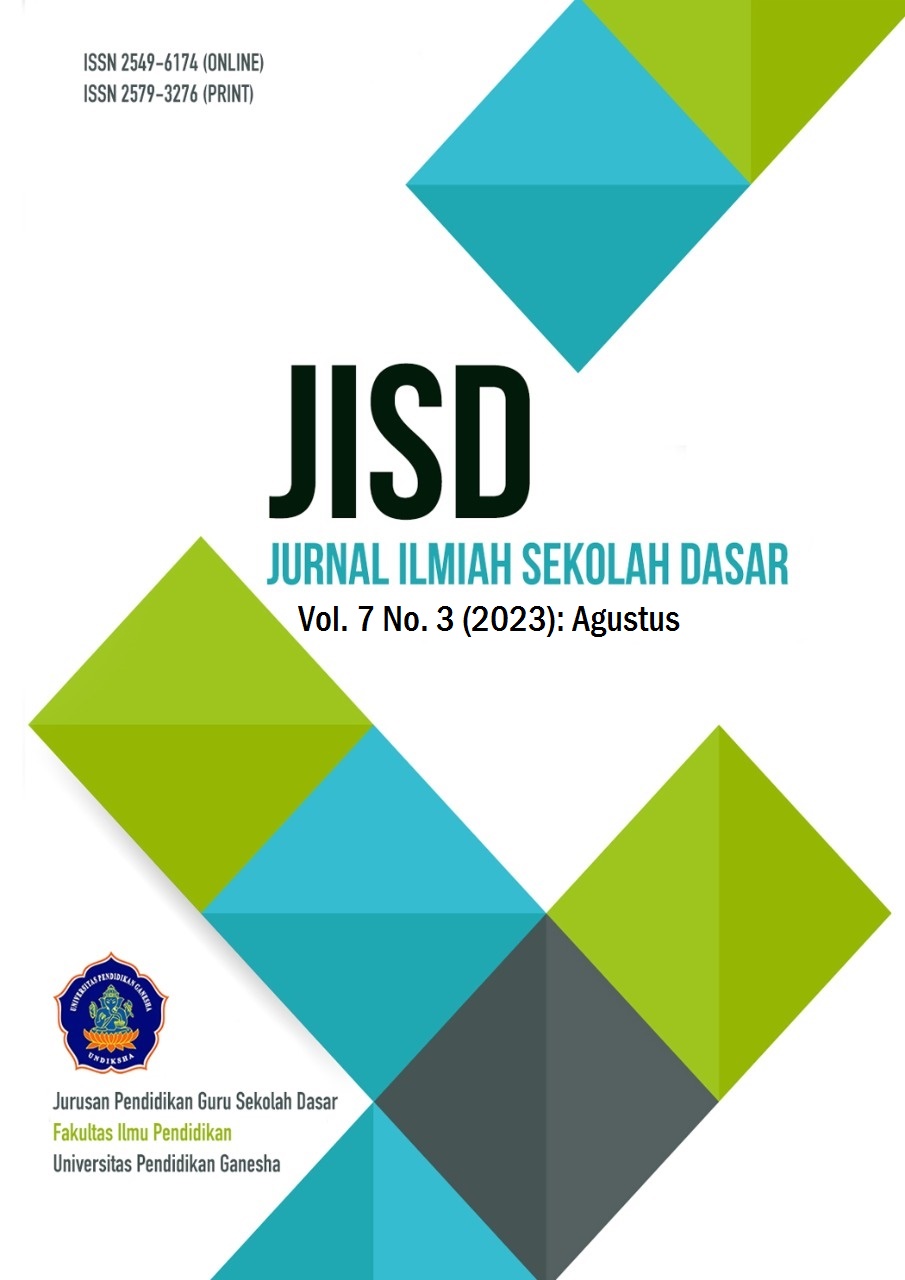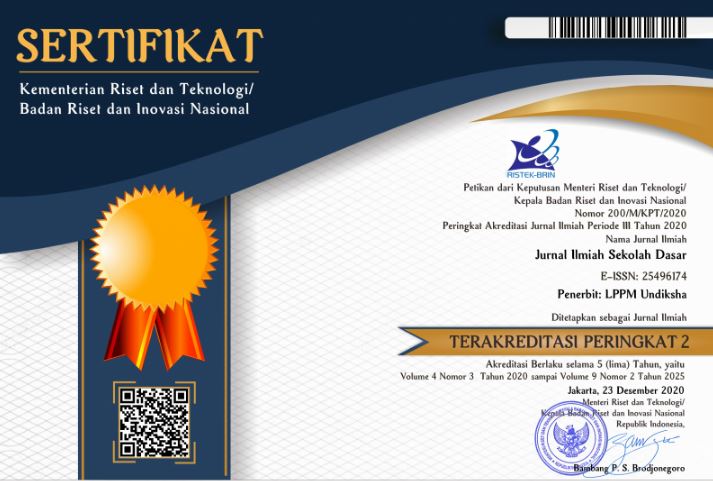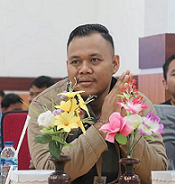Higher Order Thinking Skills in Evaluation of IV Grade Thematic Materials in Elementary Schools
DOI:
https://doi.org/10.23887/jisd.v7i3.57003Keywords:
Development, HOTS, Thematic, 21st centuryAbstract
Teachers still experience difficulties and are not optimal in compiling HOTS-based questions, so students' critical thinking skills become less than optimal. This study aims to develop higher-order thinking skills or Higher Order Thinking Skills known as HOTS. The type of research used is R&D with qualitative and quantitative approaches. The development model using Martin Tessmer's model consists of the Preliminary, Self-Evaluation, and Prototyping Stage. The method used in collecting data is a questionnaire. The instrument used in collecting data is a questionnaire. Questions and validation tests were carried out on 2 lecturers and 2 teachers. The trial is limited to 10 students, and the test is broad for all fourth-grade students. Data analysis techniques using qualitative and quantitative descriptive analysis. The study results prove that the questions developed are suitable for learning. Therefore, it can be concluded that research on the development of Higher Order Thinking Skills or HOTS on thematic questions is appropriate for use in learning in grade IV of elementary schools. Thinking Skills or HOTS on thematic questions are appropriate for learning in grade IV of elementary school.
References
Adzobu, N, Y. (2014). Design, Use and Evaluation of E-Learning Platforms: Experiences and Perspectives of a Practitioner from the Developing World Studying in the Developed World. Informatics, 1, 147–159. https://doi.org/10.3390/informatics1020147. DOI: https://doi.org/10.3390/informatics1020147
Anagün Assoc, Ş. S., & Osmangazi Üniversitesi, E. (2018). Teachers’ Perceptions about the Relationship between 21st Century Skills and Managing Constructivist Learning Environments. International Journal of Instruction, 11(4). www.e-iji.net. DOI: https://doi.org/10.12973/iji.2018.11452a
Benmarrakchi, F., El Kafi, J., & Elhore, A. (2017). Communication technology for users with specific learning disabilities. Procedia Computer Science, 110, 258–265. https://doi.org/10.1016/j.procs.2017.06.093. DOI: https://doi.org/10.1016/j.procs.2017.06.093
Bilbao, J., Bravo, E., García, O., Rebollar, C., & Varela, C. (2021). Study to find out the perception that first year students in engineering have about the Computational Thinking skills, and to identify possible factors related to the ability of Abstraction. Heliyon, 7(2). https://doi.org/10.1016/j.heliyon.2021.e06135. DOI: https://doi.org/10.1016/j.heliyon.2021.e06135
Budsankom, P., Sawangboon, T., Damrongpanit, S., & Chuensirimongkol, J. (2015). Factors affecting higher order thinking skills of students: a meta-analytic structural equation modeling study. Academic Journals, 10(19), 2639–2652. https://doi.org/10.5897/ERR2015. DOI: https://doi.org/10.5897/ERR2015.2371
Desyandri, D., Yeni, I., Mansurdin, M., & Dilfa, A. H. (2021). Digital Student Songbook as Supporting Thematic Teaching Material in Elementary School. Jurnal Ilmiah Sekolah Dasar, 5(2), 342. https://doi.org/10.23887/jisd.v5i2.36952. DOI: https://doi.org/10.23887/jisd.v5i2.36952
Detterbeck, K., & Sciangula, M. (2017). Innovation Through Collaboration: Using an Open-Source Learning Management System to Enhance Library Instruction and Student Learning. In Distributed Learning: Pedagogy and Technology in Online Information Literacy Instruction (pp. 221–238). Elsevier Inc. https://doi.org/10.1016/B978-0-08-100598-9.00012-X. DOI: https://doi.org/10.1016/B978-0-08-100598-9.00012-X
Dewi, N. K. S. (2021). EFL Pre-Service Teachers’ Perception of Their Readiness in Teaching Online during Covid-19 Pandemic. The Art of Teaching English as a Foreign Language, 2(2), 163–168. https://doi.org/10.36663/tatefl.v2i1.172. DOI: https://doi.org/10.36663/tatefl.v2i2.172
Fadilah, D., Kudsiah, M., Karlinda, N., & Haifaturrahmah. (2021). Pengembangan Bank Soal Tematik Berbasis Higher Order Thinking Skills (HOTS) di Sekolah Dasar. JIPD (Jurnal Inovasi Pendidikan Dasar, 5(1), 6–11. https://doi.org/10.36928/jipd.v5i1.704. DOI: https://doi.org/10.36928/jipd.v5i1.704
Fanani, A., & Kusmaharti, D. (2018). Pengembangan Pembelajaran Berbasis HOTS (Higher Order Thinking Skill) di Sekolah Dasar Kelas V. Jurnal Penndidikan Dasar, 1(9), 1–11. https://journal.unj.ac.id/unj/index.php/jpd/article/view/JPD.91.01.
Fuadi, I., Minarni, A., & Banjarnahor, H. (2017). Analysis of Students’ Mathematical Problem Solving Ability in IX Grade at Junior High School Ar-Rahman Percut. International Journal of Novel Research in Education and Learning, 4(2), 153–159. http://digilib.unimed.ac.id/id/eprint/39202.
Haataja, E. S. H., Tolvanen, A., Vilppu, H., Kallio, M., Peltonen, J., & Metsäpelto, R. L. (2023). Measuring higher-order cognitive skills with multiple choice questions –potentials and pitfalls of Finnish teacher education entrance. Teaching and Teacher Education, 122. https://doi.org/10.1016/j.tate.2022.103943. DOI: https://doi.org/10.1016/j.tate.2022.103943
Hosnan. (2014). Pendekatan Saintifik dan Kontekstual dalam Pembelajaran Abad 21. Ghalia Indonesia.
Karar, E. E., & Yenice, N. (2012). The Investigation of Scientific Process Skill Level of Elementary Education 8th Grade Students in View of Demographic Features. Procedia - Social and Behavioral Sciences, 46, 3885–3889. https://doi.org/10.1016/j.sbspro.2012.06.166. DOI: https://doi.org/10.1016/j.sbspro.2012.06.166
Khiyarusoleh, U. (2016). Konsep Dasar Perkembangan Kognitif Pada Anak Menurut Jean Piaget. Dialektika PGSD, 5(1), 1–10. https://journal.peradaban.ac.id/index.php/jdpgsd/article/view/17.
Komara, E. (2018). Penguatan Pendidikan Karakter dan Pembelajaran Abad 21. SIPATAHOENAN: South-East Asian Journal for Youth, Sports & Health Education, 4(1), 1–10. www.journals.mindamas.com/index.php/sipatahoenan.
Kwangmuang, P., Jarutkamolpong, S., Sangboonraung, W., & Daungtod, S. (2021). The development of learning innovation to enhance higher order thinking skills for students in Thailand junior high schools. Heliyon, 7(6), 1–13. https://doi.org/10.1016/j.heliyon.2021.e07309. DOI: https://doi.org/10.1016/j.heliyon.2021.e07309
Lusiana, T. V., & S, Y. S. A. (2022). Analisis kemampuan berpikir kritis pembagian pecahan pada mata pelajaran matematika peserta didik kelas v sd negeri tegalayu Surakarta. Didaktika Dwija Indria, 10(4), 1–6. https://digilib.uns.ac.id/dokumen/detail/92579/.
Mahalingam, M., & Fasella, E. (2017). Effective use of technology for asynchronous learning to elevate students’ knowledge and problem-solving ability. In Unplugging the Classroom: Teaching with Technologies to Promote Students’ Lifelong Learning (pp. 149–158). Elsevier Inc. https://doi.org/10.1016/B978-0-08-102035-7.00011-4. DOI: https://doi.org/10.1016/B978-0-08-102035-7.00011-4
Mar’atul Uswah, E., & Wardani, K. (2021). Analisis Higher Order Thinking Skills (HOTS) pada Evaluasi Tematik Bermuatan IPS Siswa Kelas V SDN Badran Yogyakarta. Jurnal Trihayu, 7(2), 1119–1128. https://edukasi.kompas.com/read/2018/11/12/21323. DOI: https://doi.org/10.30738/trihayu.v7i2.9173
Mardiana, H. (2020). Lecturers’ Adaptability to Technological Change and Its Impact on The Teaching Process. JPI (Jurnal Pendidikan Indonesia), 9(2), 275–289. https://doi.org/10.23887/jpi-undiksha.v9i2.24595. DOI: https://doi.org/10.23887/jpi-undiksha.v9i2.24595
Morrar, R., Arman, H., & Mousa, S. (2017). The fourth industrial revolution (Industry 4.0): A social innovation perspective. Technology Innovation Management Review, 7(11), 12–20. https://timreview.ca/sites/default/files/Issue_PDF/TIMReview_November2017.pdf#page=12. DOI: https://doi.org/10.22215/timreview/1117
Nofrion, N., & Wijayanto, B. (2018). Learning activities in higher order thinking skill (HOTS) oriented learning context. Geosfera Indonesia, 3(2), 122. https://doi.org/10.19184/geosi.v3i2.8126. DOI: https://doi.org/10.19184/geosi.v3i2.8126
Novita, K., & Novianty, A. (2020). Pengaruh Penggunaan Media Pembelajaran Audio Visual Animasi Terhadap Hasil Belajar Subtema benda Tunggal dan Campuran. JTIEE, 3(1), 46–53. https://doi.org/10.30587/jtiee.v3i1.1127. DOI: https://doi.org/10.30587/jtiee.v3i1.1127
Obradović, S., Bjekić, D., & Zlatić, L. (2015). Creative Teaching with ICT Support for Students with Specific Learning Disabilities. Procedia - Social and Behavioral Sciences, 203, 291–296. https://doi.org/10.1016/j.sbspro.2015.08.297. DOI: https://doi.org/10.1016/j.sbspro.2015.08.297
Pachler, D., Kuonath, A., & Frey, D. (2019). How transformational lecturers promote students’ engagement, creativity, and task performance: The mediating role of trust in lecturer and self-efficacy. Learning and Individual Differences, 69, 162–172. https://doi.org/10.1016/j.lindif.2018.12.004. DOI: https://doi.org/10.1016/j.lindif.2018.12.004
Polat, Ö., & Aydın, E. (2020). The effect of mind mapping on young children’s critical thinking skills. Thinking Skills and Creativity, 38. https://doi.org/10.1016/j.tsc.2020.100743. DOI: https://doi.org/10.1016/j.tsc.2020.100743
Puspitasari, D., Widodo, H. P., Widyaningrum, L., Allamnakhrah, A., & Lestariyana, R. P. D. (2021). How do primary school English textbooks teach moral values? A critical discourse analysis. Studies in Educational Evaluation, 70, 101044. https://doi.org/10.1016/j.stueduc.2021.101044. DOI: https://doi.org/10.1016/j.stueduc.2021.101044
Redhana, I. W. (2019). Mengembangkan Keterampilan Abad ke-21 dalam Pembelajaran Kimia. Jurnal Inovasi Pendidikan Kimia, 13(1). https://doi.org/10.15294/jipk.v13i1.17824.
Soleh, A. R., & Arifin, Z. (2021). Integrasi Keterampilan Abad 21 dalam Pengembangan Perangkat Pembelajaran pada Konsep Community of Inquiry. QALAMUNA: Jurnal Pendidikan, Sosial, Dan Agama, 13(2), 473–490. https://doi.org/10.37680/qalamuna.v13i2.995. DOI: https://doi.org/10.37680/qalamuna.v13i2.995
Suarti, S., & Ramadhani, A. R. A. (2022). Analisis Keterampilan Berpikir Kritis dalam Menyelesaikan Soal Termodinamika melalui Model SQ3R (Survey, Question, Read, Recite, Review. Al-Khazini: Jurnal Pendidikan Fisika, 2(1), 31–37. https://doi.org/10.24252/al-khazini.v2i1.31545. DOI: https://doi.org/10.24252/al-khazini.v2i1.31545
Suknaisith, A., Wongwanich, S., & Piromsombat, C. (2014). Development of Teacher Performance in Educational Measurements and Evaluation through Self-monitoring Strategies. Procedia - Social and Behavioral Sciences, 116, 1683–1688. https://doi.org/10.1016/j.sbspro.2014.01.456. DOI: https://doi.org/10.1016/j.sbspro.2014.01.456
Widhiyani, I. A. N. T., Sukajaya, I. N., & Suweken, G. (2019). Pengembangan Soal Higher Order Thinking Skills untuk Pengkategorian Kemampuan Pemecahan Masalah Geometri Siswa SMP. Jurnal Pendidikan Dan Pembelajaran Matematika Indonesia, 8(2), 161–170. https://doi.org/10.23887/jppm.v8i2.2854. DOI: https://doi.org/10.23887/jppm.v8i2.2854
Wulandari, I. G. A. A. M., Sudatha, I. G. W., & Simamora, A. H. (2020). Pengembangan Pembelajaran Blended Pada Mata Kuliah Ahara Yoga Semester II di IHDN Denpasar. Jurnal Edutech Undiksha, 8(1), 1. https://doi.org/10.23887/jeu.v8i1.26459. DOI: https://doi.org/10.23887/jeu.v8i1.26459
Yuliandini, N., Hamdu, G., & Respati, R. (2019). Pengembangan Soal Tes Berbasis Higher Order Thinking Skill (Hots Taksonomi Bloom Revisi di Sekolah Dasar. PEDADIDAKTIKA: Jurnal Ilmiah Pendidikan Guru Sekolah Dasar, 6(1), 37–46. https://doi.org//10.17509/pedadidaktika.v6i1.12563.
Yulinawati, L., & Wahyuningsih, S. (2022). Analisis penerapan konsep critical thinking dalam pelajaran ipa selama pembelajaran daring kelas v sekolah dasar. Jurnal Pendidikan Indonesia, 8(1). https://doi.org/10.20961/jpi.v8i1.60159.
Downloads
Published
How to Cite
Issue
Section
License
Copyright (c) 2023 Lina Novita

This work is licensed under a Creative Commons Attribution-ShareAlike 4.0 International License.
Authors who publish with the Journal Ilmiah Sekolah Dasar agree to the following terms:
- Authors retain copyright and grant the journal the right of first publication with the work simultaneously licensed under a Creative Commons Attribution License (CC BY-SA 4.0) that allows others to share the work with an acknowledgment of the work's authorship and initial publication in this journal.
- Authors are able to enter into separate, additional contractual arrangements for the non-exclusive distribution of the journal's published version of the work (e.g., post it to an institutional repository or publish it in a book), with an acknowledgment of its initial publication in this journal.
- Authors are permitted and encouraged to post their work online (e.g., in institutional repositories or on their website) prior to and during the submission process, as it can lead to productive exchanges, as well as earlier and greater citation of published work. (See The Effect of Open Access)










